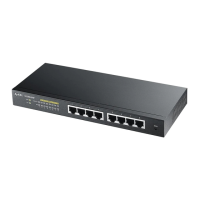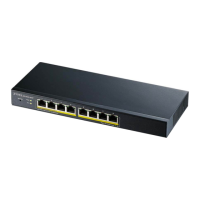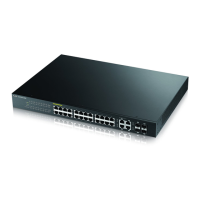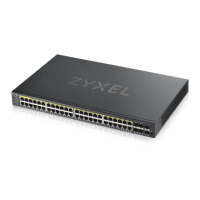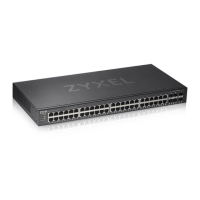
Do you have a question about the ZyXEL Communications GS1900-24HP and is the answer not in the manual?
| Model | GS1900-24HP |
|---|---|
| PoE | Yes |
| PoE Power Budget | 370W |
| PoE Standard | IEEE 802.3af/at |
| MAC Address Table | 8K |
| Jumbo Frame | 9KB |
| VLAN Support | Yes |
| Quality of Service (QoS) | Yes |
| Power Supply | Internal |
| Weight | 3.5 kg |
| Operating Humidity | 10% to 90% (non-condensing) |
| Type | Managed Switch |
| Layer | Layer 2 |
| Features | IGMP Snooping |
| Management | Web-based |
| Dimensions (W x D x H) | 440 x 44 x mm |
| Operating Temperature | 0°C to 40°C |
| Ports | 24 x 10/100/1000BASE-T ports |
Outlines safety measures to observe before using the switch, including clearance and handling.
Shows figures of the front panels of various GS1900 switch models.
Details the steps for installing an SFP transceiver, including ESD precautions.
Explains the importance of grounding for safety and how to properly ground the switch.
Introduces ZON Utility as a program for deploying and managing networks efficiently.
Guides users on how to launch the ZON Utility and navigate its initial screens.
Provides instructions on how to access the Web Configurator via a web browser.
Allows configuration of general identification information and time settings for the switch.
Enables configuration of port settings like speed, flow control, and priority.
Allows configuration of VLAN, guest VLAN, and voice VLAN settings.
Provides access to configure port security, 802.1X, and DoS settings.
Manages firmware upload and dual image information for the switch.
Manages backup, restore, and factory default configuration files for the switch.
Provides tools to view system logs and perform network tests like port tests and ping tests.
Describes the initial screen seen after login, displaying device info and status in widgets.
Covers initial setup steps like IP/DNS configuration, user name/password, and viewing results.
Details the need for an IP address for network management and covers IPv4 and IPv6 settings.
Guides on viewing the switch's IPv4 interface status and management IP addresses.
Allows viewing switch port settings, including status, port counters, and bandwidth utilization.
Details Power over Ethernet (PoE) functionality and related screens, available on specific models.
Shows how to view bandwidth management settings for incoming and outgoing traffic flows on ports.
Allows viewing switch VLAN settings, including VLAN, port, and VLAN port configurations.
Details how to configure a guest VLAN for providing limited network access to unauthenticated users.
Allows viewing static MAC addresses and MAC table settings, including dynamic and static MAC addresses.
Allows viewing switch link aggregation status, supporting both static and dynamic modes.
Allows viewing switch loop guard status and configuring ports to shut down if loops are detected.
Allows viewing switch multicast features, including IGMP VLAN, statistics, group, profile, and throttling.
Explains how STP prevents network loops and provides backup links.
Allows viewing the switch's spanning tree CIST port status and parameters.
Allows viewing the switch's spanning tree MST port status and parameters.
Allows viewing and configuring LLDP port settings, including statistics, remote information, and overloading.
Allows viewing LLDP remote device information, such as chassis ID, port ID, and system name.
Configures port security to allow only authorized MAC addresses to pass through a port.
Details 802.1X security settings, including port status and authenticated hosts.
Displays the status of 802.1x authenticated hosts, including username, port, and authentication method.
Configures Syslog management, allowing selection of logging targets and viewing system logs.
Details the need for an IP address for network management and covers IPv4 and IPv6 settings.
Guides on viewing the switch's IPv4 interface status and management IP addresses.
Covers system time and SNTP server settings for accurate time synchronization.
Allows viewing and editing general port settings, including status, speed, and duplex.
Allows configuring switch port settings like state, speed, duplex, and flow control.
Details Power over Ethernet (PoE) support and global settings for power management.
Guides on viewing switch port PoE settings and selecting ports for configuration.
Defines maximum allowable bandwidth for incoming and outgoing traffic flows on ports.
Explains how storm control limits broadcast, multicast, and DLF packets to reduce network traffic.
Allows configuring Storm Control settings for individual ports, including action and limits.
Allows viewing and configuring VLAN settings, including VLAN, port, and VLAN port configurations.
Allows adding new VLAN entries by specifying VLAN IDs and names.
Allows configuring port settings for VLANs, including PVID, accepted frame type, and VLAN trunking.
Allows configuring global Guest VLAN settings, including state and guest VLAN ID.
Allows configuring guest VLAN port settings, including state and edit options.
Provides information on Loop Guard, designed to protect against network loops on the edge.
Allows restoring a previously saved device configuration from a server or computer.
Allows resetting the switch to its original factory settings.
Provides steps to reset the switch to factory defaults using the Restore button.

